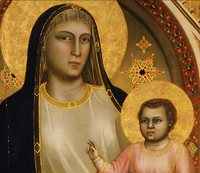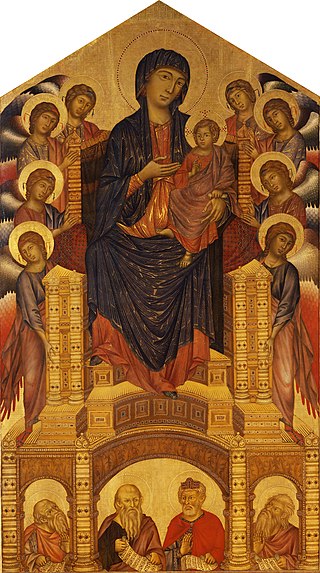
Giovanni Cimabue, c. 1240 – 1302, was an Italian painter and designer of mosaics from Florence. He was also known as Cenni di Pepo or Cenni di Pepi.

The Uffizi Gallery is a prominent art museum located adjacent to the Piazza della Signoria in the Historic Centre of Florence in the region of Tuscany, Italy. One of the most important Italian museums and the most visited, it is also one of the largest and best-known in the world and holds a collection of priceless works, particularly from the period of the Italian Renaissance.
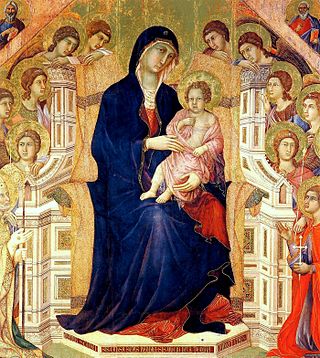
Duccio di Buoninsegna, commonly known as just Duccio, was an Italian painter active in Siena, Tuscany, in the late 13th and early 14th century. He was hired throughout his life to complete many important works in government and religious buildings around Italy. Duccio is considered one of the greatest Italian painters of the Middle Ages, and is credited with creating the painting styles of Trecento and the Sienese school. He also contributed significantly to the Sienese Gothic style.

Lorenzo Monaco was an Italian painter and miniaturist of the late Gothic to early Renaissance age. He was born Piero di Giovanni. Little is known about his youth, apart from the fact that he was apprenticed in Florence. He has been considered the last important exponent of the Giotto style, before the Renaissance revolution that came with Fra Angelico and Masaccio.

Ambrogio Lorenzetti was an Italian painter of the Sienese school. He was active from approximately 1317 to 1348. He painted The Allegory of Good and Bad Government in the Sala dei Nove in Siena's Palazzo Pubblico. His elder brother was the painter Pietro Lorenzetti.

Pietro Lorenzetti or Pietro Laurati was an Italian painter, active between c. 1306 and 1345. Together with his younger brother Ambrogio, he introduced naturalism into Sienese art. In their artistry and experiments with three-dimensional and spatial arrangements, the brothers foreshadowed the art of the Renaissance.

Bernardo Daddi was an early Italian Renaissance painter and the leading painter of Florence of his generation. He was one of the artists who contributed to the revolutionary art of the Renaissance, which broke away from the conventions of the preceding generation of Gothic artists, by creating compositions which aimed to achieve a more realistic representation of reality. He was particularly successful with his small-scale works and contributed to the development of the portable altarpiece, a format that subsequently gained great popularity.

Florentine painting or the Florentine school refers to artists in, from, or influenced by the naturalistic style developed in Florence in the 14th century, largely through the efforts of Giotto di Bondone, and in the 15th century the leading school of Western painting. Some of the best known painters of the earlier Florentine School are Fra Angelico, Botticelli, Filippo Lippi, the Ghirlandaio family, Masolino, and Masaccio.

Lippo Memmi was an Italian painter from Siena. He was the foremost follower of Simone Martini, who was his brother-in-law.

Italian Renaissance painting is the painting of the period beginning in the late 13th century and flourishing from the early 15th to late 16th centuries, occurring in the Italian Peninsula, which was at that time divided into many political states, some independent but others controlled by external powers. The painters of Renaissance Italy, although often attached to particular courts and with loyalties to particular towns, nonetheless wandered the length and breadth of Italy, often occupying a diplomatic status and disseminating artistic and philosophical ideas.

This article about the development of themes in Italian Renaissance painting is an extension to the article Italian Renaissance painting, for which it provides additional pictures with commentary. The works encompassed are from Giotto in the early 14th century to Michelangelo's Last Judgement of the 1530s.
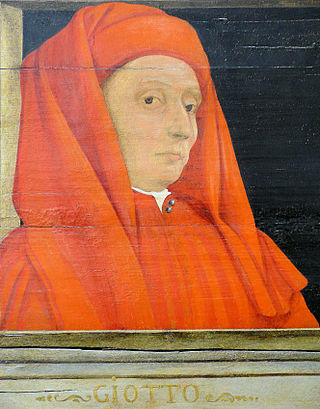
Giotto di Bondone, known mononymously as Giotto, was an Italian painter and architect from Florence during the Late Middle Ages. He worked during the Gothic and Proto-Renaissance period. Giotto's contemporary, the banker and chronicler Giovanni Villani, wrote that Giotto was "the most sovereign master of painting in his time, who drew all his figures and their postures according to nature" and of his publicly recognized "talent and excellence". Giorgio Vasari described Giotto as making a decisive break from the prevalent Byzantine style and as initiating "the great art of painting as we know it today, introducing the technique of drawing accurately from life, which had been neglected for more than two hundred years".
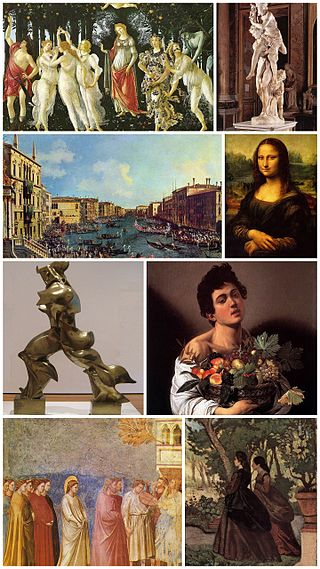
Duecento or Dugento is the Italian word for the Italian culture of the 13th century - that is to say 1200 to 1299. During this period the first shoots of the Italian Renaissance appeared, in literature and art, to be developed in the following trecento period.

Saint Francis Receiving the Stigmata is a panel painting in tempera by the Italian artist Giotto, painted around 1295–1300 for the Church of Saint Francis in Pisa and it is now in the Musée du Louvre in Paris. It shows an episode from the life of Saint Francis of Assisi, and is 314 cm high by 162 cm wide. It is signed OPUS IOCTI FLORENTINI.

The Maestà is a painting by the Italian artist Cimabue, executed around 1280 and now in the Musée du Louvre in Paris.

The Rucellai Madonna is a panel painting representing the Virgin and Child enthroned with Angels by the Sienese painter Duccio di Buoninsegna. The original contract for the work is dated 1285; the painting was probably delivered in 1286. The painting was commissioned by the Laudesi confraternity of Florence to decorate the chapel they maintained in the Dominican church of Santa Maria Novella. It was transferred to the Galleria degli Uffizi in the 19th century. The Rucellai Madonna is the largest 13th-century panel painting extant.
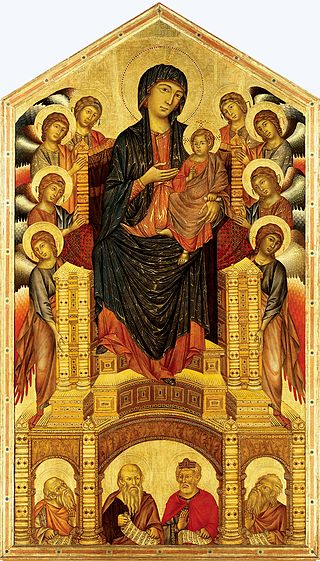
The Santa Trinita Maestà is a panel painting by the Italian medieval artist Cimabue, dating to c. 1288-1292. Originally painted for the church of Santa Trinita, Florence, where it remained until 1471, it is now in the Uffizi Gallery of Florence, Italy. It represents the Madonna enthroned with the Baby Jesus and surrounded by eight angels and, below, four half portraits of prophets.

Cimabue's Celebrated Madonna, originally called Cimabue's [Celebrated] Madonna [is] Carried in Procession through the Streets of Florence, is an oil painting by English artist Frederic Leighton. Measuring more than two metres tall and more than five metres wide, the canvas was painted by Leighton from 1853 to 1855 in Rome as his first major work.

Italo-Byzantine is a style term in art history, mostly used for medieval paintings produced in Italy under heavy influence from Byzantine art. It initially covers religious paintings copying or imitating the standard Byzantine icon types, but painted by artists without a training in Byzantine techniques. These are versions of Byzantine icons, most of the Madonna and Child, but also of other subjects; essentially they introduced the relatively small portable painting with a frame to Western Europe. Very often they are on a gold ground. It was the dominant style in Italian painting until the end of the 13th century, when Cimabue and Giotto began to take Italian, or at least Florentine, painting into new territory. But the style continued until the 15th century and beyond in some areas and contexts.
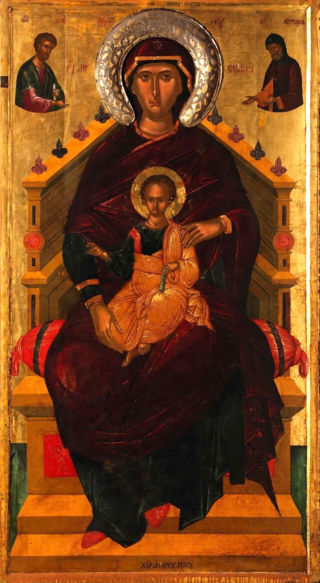
The Virgin Pantanassa is a tempera painting by Andreas Ritzos. Ritzos was a Greek painter active on the island of Crete. He flourished from 1435 to 1492. The painter has an existing catalog of over sixty works attributed to him. He signed his works in both Greek and Latin. He is one of the most influential painters of the Cretan Renaissance. He painted in the traditional Greek-Italian Byzantine style. His work was also heavily influenced by Venetian painting. His teacher was Angelos Akotantos. He was also affiliated with Andreas Pavias. His son was famous Greek painter Nikolaos Ritzos. Ritzo's Italian contemporaries were Paolo Uccello and Fra Angelico. They all painted a mixture of the Greek-Italian Byzantine and Italian Renaissance styles. The art of Crete was heavily influenced by the founder of the Venetian school Paolo Veneziano.






















